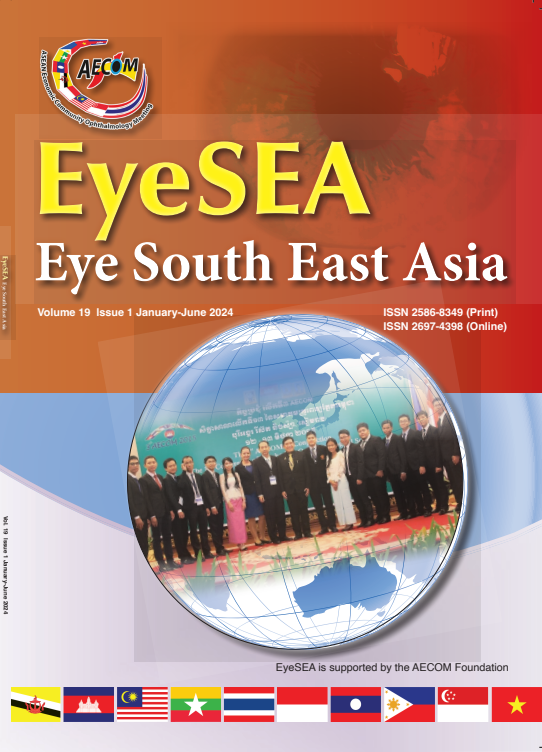Effectiveness of Phacoemulsification with Goniosynechialysis in Angle Closure
Main Article Content
Abstract
Objective: To study the effect of phacoemulsification with goniosynechialysis on the reduction of intraocular pressure and the medications usage in the treatment of patients with angle closure glaucoma.
Materials and Methods: Patients who underwent phacoemulsification with goniosynechialysis between January 2019 and January 2022 were included in the study. Patient histories and records were obtained from the electronic hospital database.
Results: A total of 28 patients were included in this study, 75% being female, were enrolled in the study. The distribution of left and right eyes was equal. The average age of the patients was 59.28±8.04 years, and the mean visual acuity was Logmar 0.92±0.46. The average intraocular pressure (IOP) at baseline was 25.07±12.66 mmHg, ranging from 9 to 55 mmHg. The patients were using an average of 2.86±1.33 types of glaucoma medications. After 3 months of treatment, the average number of drops of glaucoma medications used decreased from 3.93 to 1.64 drops (P= <0.001, 95%CI [1.35,3.22]). The average intraocular pressure decreased from 25.07 mmHg to 12.75 mmHg (P= <0.001, 95%CI [7.76,16.88]), and the average number of types of glaucoma medications decreased from 2.86 to 1.53 (P= <0.001, 95%CI [0.65,2.00]).
Conclusions: Phacoemulsification with goniosynechialysis has been shown to be effective in lowering intraocular pressure in patients with angle closure glaucoma. Additionally, this procedure has the potential to decrease the number and types of glaucoma medications needed for managing the condition.
Article Details

This work is licensed under a Creative Commons Attribution-NonCommercial-NoDerivatives 4.0 International License.
References
Resnikoff S, Pascolini D, Etya’ale D, Kocur I, Pararajasegaram R, Pokharel GP, et al. Global data on visual impairment in the year 2002. Bull World Health Organ. 2004; 82:844-51. Epub 2004 Dec 14.
Tham YC, Li X, Wong TY, Quigley HA, Aung T, Cheng CY. Global prevalence of glaucoma and projections of glaucoma burden through 2040: a systematic review and meta-analysis. Ophthalmology. 2014;121(11):2081-90.
Asanathong D. Prevalence of Glaucoma Patient at Sisaket Hospital During World Glaucoma Day. MJSSBH. 2020;35(3):749-56.
European Glaucoma Society Terminology and Guidelines for Glaucoma. 4th Edition - Chapter 3: Treatment principles and options Supported by the EGS Foundation: Part 1: Foreword; Introduction; Glossary; Chapter 3 Treatment principles and options. Br J Ophthalmol. 2017;101(6):130-95.
Anderson DR, Jin JC, Wright MM. The physiologic characteristics of relative pupillary block. Am J Ophthalmol. 1991;111(3):344-50.
Husain R, Gazzard G, Aung T, Chen Y, Padmanabhan V, Oen FTS, et al. Initial management of acute primary angle closure: a randomized trial comparing phacoemulsification with laser peripheral iridotomy. Ophthalmology. 2012;119(11): 2274-81.
Lam DSC, Leung DYL, Tham CCY, Li FCH, Kwong YYY, Chiu TYH, et al. Randomized trial of early phacoemulsification versus peripheral iridotomy to prevent intraocular pressure rise after acute primary angle closure. Ophthalmology. 2008 ;115(7):1134-40.
Chen YY, Fan SJ, Liang YB, Rong SS, Meng HL, Wang X, et al. Laser Peripheral Iridotomy versus Trabeculectomy as an Initial Treatment for Primary Angle-Closure Glaucoma. J Ophthalmol. 2017;2761301.
Rajavi Z, Moezzi-Ghadim H, Kamrava K. The effect of trabeculectomy on cataract formation or progression. J Ophthalmic Vis Res. 2009;4(2):84-9.
Dada T, Bhartiya S, Begum Baig N. Cataract Surgery in Eyes with Previous Glaucoma Surgery: Pearls and Pitfalls. J Curr Glaucoma Pract. 2013;7(3):99-105.
Hansapinyo L, Choy BNK, Lai JSM, Tham CC. Phacoemulsification Versus Phacotrabeculectomy in Primary Angle-closure Glaucoma With Cataract: Long-Term Clinical Outcomes. J Glaucoma. 2020;29(1):15-23.
Yu JG, Zhao F, Xiang Y. Phacoemulsification with Goniosynechialysis versus Phacoemulsification Alone in Angle-Closure Glaucoma: A Meta-Analysis of Randomized Controlled Trials. J Ophthalmol. 2021;8831479.
Wang N, Jia SB. Phacoemulsification with or without goniosynechialysis for angle-closure glaucoma: a global Meta-analysis based on randomized controlled trials. Int J Ophthalmol. 2019;12(5):826-33.
Teekhasaenee C, Ritch R. Combined phacoemulsification and goniosynechialysisfor uncontrolled chronic angle-closureglaucoma after acute angle-closure glaucoma. Ophthalmology. 1999;106(4):669-75.
Wanichwecharungruang B, Phumratprapin C, Kongsomboon K, Seresirikachorn K. Real-world Surgical Outcomes of Primary Angle-closure Glaucoma. Clin Ophthalmol. 2021;15:2823-33.
Tian T, Li M, Pan Y, Cai Y, Fang Y. The effect of phacoemulsification plus goniosynechialysis in acute and chronic angle closure patients with extensive goniosynechiae. BMC Ophthalmol. 2019;19(1):65.
Husain R, Do T, Lai J, Kitnarong N, Nongpiur ME, Perera SA, et al. Efficacy of phacoemulsification alone vs phacoemulsification with goniosynechialysis in patients with primary angle-closure disease: a randomized clinical trial. JAMA Ophthalmol. 2019;137(10):1107-13.
Bourne RRA. Prevalence of glaucoma in Thailand: a population based survey in Rom Klao District, Bangkok. British Journal of Ophthalmology. 2003;87(9):1069-74.


